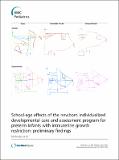School-age effects of the newborn individualized developmental care and assessment program for preterm infants with intrauterine growth restriction: preliminary findings

View/
Author
Kosta, Sandra
Alidoost, Moona
Note: Order does not necessarily reflect citation order of authors.
Published Version
https://doi.org/10.1186/1471-2431-13-25Metadata
Show full item recordCitation
McAnulty, Gloria, Frank H Duffy, Sandra Kosta, Neil I Weisenfeld, Simon K Warfield, Samantha C Butler, Moona Alidoost, et al. 2013. School-age effects of the newborn individualized developmental care and assessment program for preterm infants with intrauterine growth restriction: preliminary findings. BMC Pediatrics 13: 25.Abstract
Background: The experience in the newborn intensive care nursery results in premature infants’ neurobehavioral and neurophysiological dysfunction and poorer brain structure. Preterms with severe intrauterine growth restriction are doubly jeopardized given their compromised brains. The Newborn Individualized Developmental Care and Assessment Program improved outcome at early school-age for preterms with appropriate intrauterine growth. It also showed effectiveness to nine months for preterms with intrauterine growth restriction. The current study tested effectiveness into school-age for preterms with intrauterine growth restriction regarding executive function (EF), electrophysiology (EEG) and neurostructure (MRI). Methods: Twenty-three 9-year-old former growth-restricted preterms, randomized at birth to standard care (14 controls) or to the Newborn Individualized Developmental Care and Assessment Program (9 experimentals) were assessed with standardized measures of cognition, achievement, executive function, electroencephalography, and magnetic resonance imaging. The participating children were comparable to those lost to follow-up, and the controls to the experimentals, in terms of newborn background health and demographics. All outcome measures were corrected for mother’s intelligence. Analysis techniques included two-group analysis of variance and stepwise discriminate analysis for the outcome measures, Wilks’ lambda and jackknifed classification to ascertain two-group classification success per and across domains; canonical correlation analysis to explore relationships among neuropsychological, electrophysiological and neurostructural domains at school-age, and from the newborn period to school-age. Results: Controls and experimentals were comparable in age at testing, anthropometric and health parameters, and in cognitive and achievement scores. Experimentals scored better in executive function, spectral coherence, and cerebellar volumes. Furthermore, executive function, spectral coherence and brain structural measures discriminated controls from experimentals. Executive function correlated with coherence and brain structure measures, and with newborn-period neurobehavioral assessment. Conclusion: The intervention in the intensive care nursery improved executive function as well as spectral coherence between occipital and frontal as well as parietal regions. The experimentals’ cerebella were significantly larger than the controls’. These results, while preliminary, point to the possibility of long-term brain improvement even of intrauterine growth compromised preterms if individualized intervention begins with admission to the NICU and extends throughout transition home. Larger sample replications are required in order to confirm these results.Other Sources
http://www.ncbi.nlm.nih.gov/pmc/articles/PMC3600990/pdf/Terms of Use
This article is made available under the terms and conditions applicable to Other Posted Material, as set forth at http://nrs.harvard.edu/urn-3:HUL.InstRepos:dash.current.terms-of-use#LAACitable link to this page
http://nrs.harvard.edu/urn-3:HUL.InstRepos:10609674
Collections
- HMS Scholarly Articles [17922]
Contact administrator regarding this item (to report mistakes or request changes)


